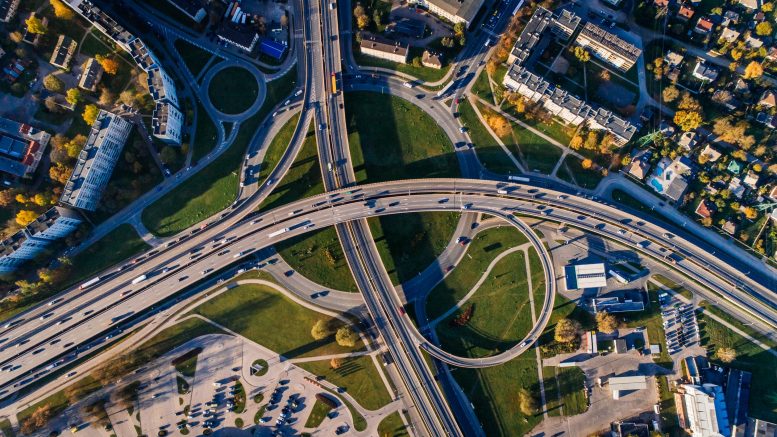Atlanta’s I-285/I-85 interchange remains No. 2 on list, but Nashville connector jumps five spots to No. 3
By Al Muskewitz
Any driver who has been stuck in traffic in a major American city for any length of time knows congestion on U.S. highways is getting worse all the time.
You may get to memorize that trucking company’s recruiting phone number on the back of the truck or have the license plate number of the car in front of you burned into your brain by the time you break free, but it’s certainly no fun.
Recent studies have indicated the number of place experiencing average daily speeds of 45 mph or less has increased 92 percent in just five years, compared to the 10 percent growth in traffic congestion over the same time period.
For the second year in a row, the intersection of Interstate 95 and State Road 4 in Fort Lee, N.J., the entrance to the George Washington Bridge and focus of the “Bridgegate” scandal during former Gov. Chris Christie’s administration, is the No. 1 freight bottleneck in the country according to research released Wednesday by the American Transportation Research Institute.
Traffic moved through the interchange at an average of 22.4 MPH during rush hour, the study revealed. It serves more than 3.5 million trucks a year.
“North Jersey commuters are as familiar with this bottleneck and its traffic jams as the sun rising up on a spring day,” U.S. Rep. Bill Pascrell Jr., whose district includes Fort Lee, was quoted as saying by NJ.com.
The interchange of Interstate 285 at I-85 (North) in Atlanta remains the second-most congested spot, but the city’s I-75 at I-285 (North) junction that had been No. 3, dropped to fifth in the latest survey, surpassed by Nashville’s I-24/40 at I-440 (up to 3 from 8) link and Houston’s I-45 at I-69/US-59 interchange (up from 5 to 4).
Atlanta still has, however, three of the top seven hotspots in the country. Texas has the most by state (11), with California, Georgia and New York each having seven.
The data was compiled using truck GPS data from nearly 1 million heavy duty trucks.
According to the ATRI data, 1.2 billion hours of trucking industry productivity are lost due to the congestion, the equivalent of 425,533 drivers sitting idle for an entire year, costing the industry $74.5 billion.
“ATA has been beating the drum about the continued degradation of our infrastructure and thanks to the ATRI’s research we can see exactly how decades of ignoring the problem are impacting not just our industry but our economy and commuters everywhere,” Americana Trucking Associations President and CEO Chris Spear said. “This report should sound the alarm for policymakers that the cost of doing nothing is too high and provide aa roadmap of where to target investments to really solve our nation’s mounting infrastructure crisis.”
City planners do take notice of the survey results. The redesign and rebuild of the Jane Byrne Interchange in Chicago (I-290 at I-90/I-94) was driven by its ranking as the nation’s No. 1 bottleneck for three consecutive years. It is currently No. 6. The city planning agency estimated 36 percent of freight truck traffic in the region passes through the area and it anticipates the $713 million project will be completed in 2022.
In seeking answers to their infrastructure issues, Middle Tennessee mayors recently declared 2020 the “Year of Transportation,” specifically studying the I-65 Southern Corridor and the Downtown Interstate Loop of I-40, 24 and 65 through Nashville.
Tennessee has six locations among the top 100 areas cited in the ATRI study, with four in the Nashville area. Studies consistently place the state’s capital and largest city among the top 25 cities nationally in all roadway congestion, a position that only figures to increase without a solution given officials estimate the Middle Tennessee region will grow by 1.2 million residents over the next 25 years.
No one has to tell the truckers who negotiate the routes around the city how tough it can be.
“Nashville has seen significant urban sprawl and economic development over the past couple decades,” TLD Logistics driver Tiny Worrell said. “It is a city that is outgrowing its original city and highway planning rapidly. It is quickly becoming comparable to cities like Atlanta in population and population density, but the highway systems seem to be lagging behind.
“In Atlanta, the main downtown highway arteries have up to eight or nine lanes and still experience heavy traffic. In Nashville, the main highways are three or four lanes at most. Thoroughfares that generally see smooth traffic flow become virtual parking lots during rush hour and in most places correcting this issue seems to be a problem due to surrounding real estate being so close to the highway. It seems that Nashville’s original city planning did not account for this level of rapid growth.”
Some drivers, like TLD’s Junior Vaughn, seek alternate routes around the city as much as possible. Others simply offer a word of advice.
“The only thing I can say,” TLD’s Skye Sweat said, “is to leave early and be vigilant.”
Here is the top 10 and how they’ve moved from last year’s survey:
1. Fort Lee, N.J.: I-95 at SR-4 (still No. 1)
2. Atlanta: I-285 at I-85 (North) (still No. 2)
3. Nashville: I-24/I-40 at I-440 (East) (up 5 spots)
4. Houston: I-45 at I-69/US 59 (up 1)
5. Atlanta: I-75 at I-285 (North) (down 2)
6. Chicago: I-290 at I-90/I-94 (up 1)
7. Atlanta: I-20 at I-285 (West) (up 2)
8. Cincinnati: I-71 at I-75 (down 2)
9. Los Angeles: SR 60 at SR 57 (down 5)
10. Los Angeles: I-710 at I-105 (remains the same)
Al Muskewitz is Editor for Wright Media Corp. He can be reached at musky@wrightmediacorp.com
N.J. Still Nation’s No. 1 Bottleneck


Be the first to comment on "N.J. Still Nation’s No. 1 Bottleneck"